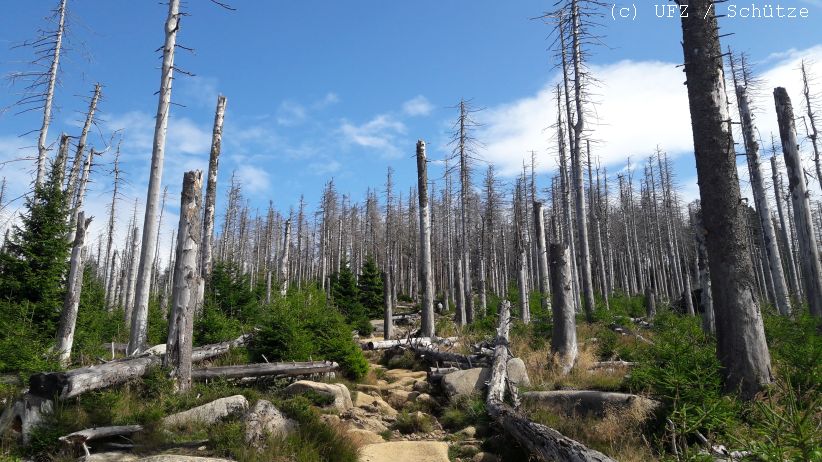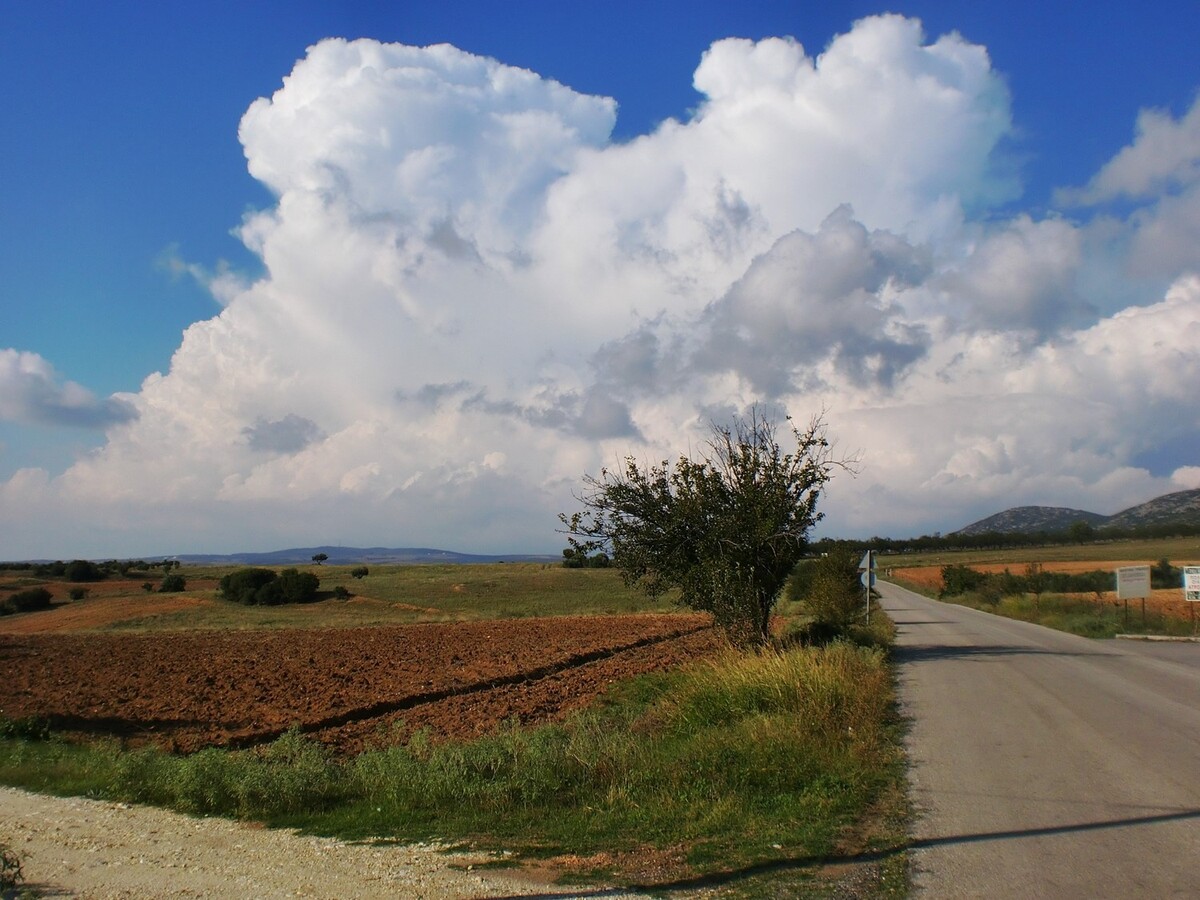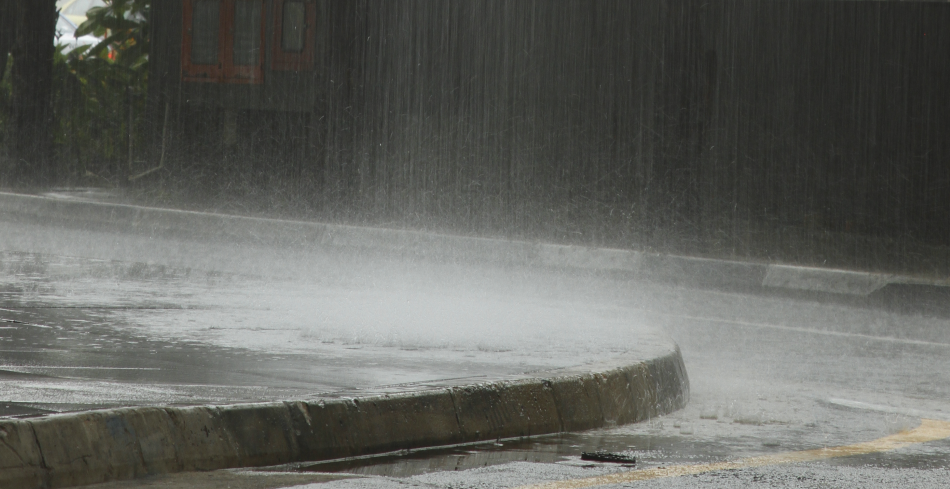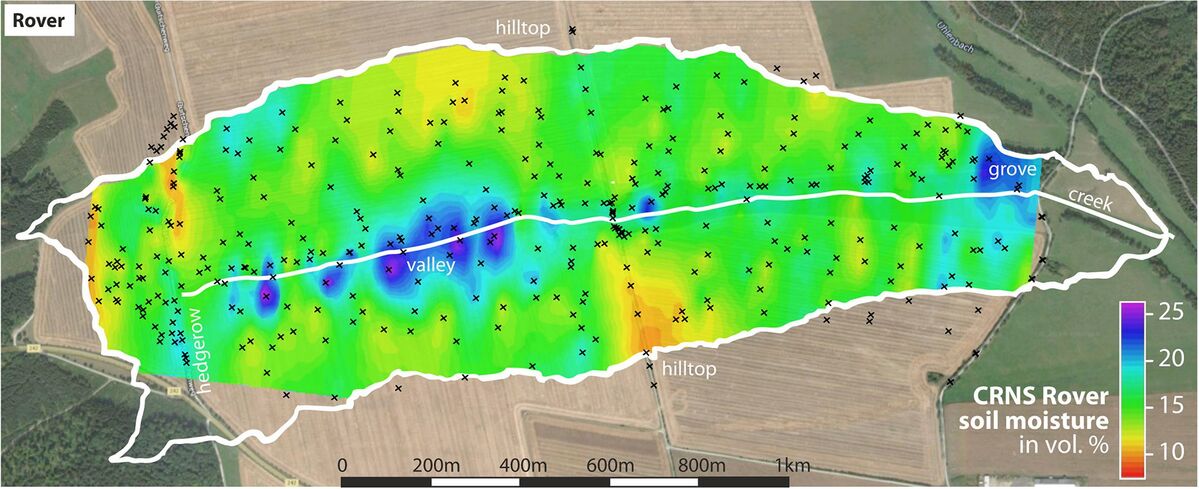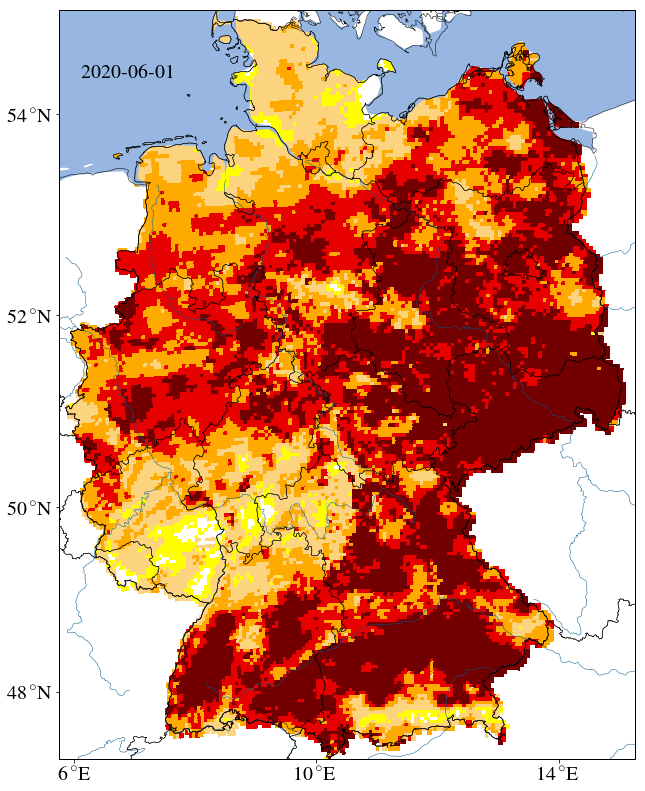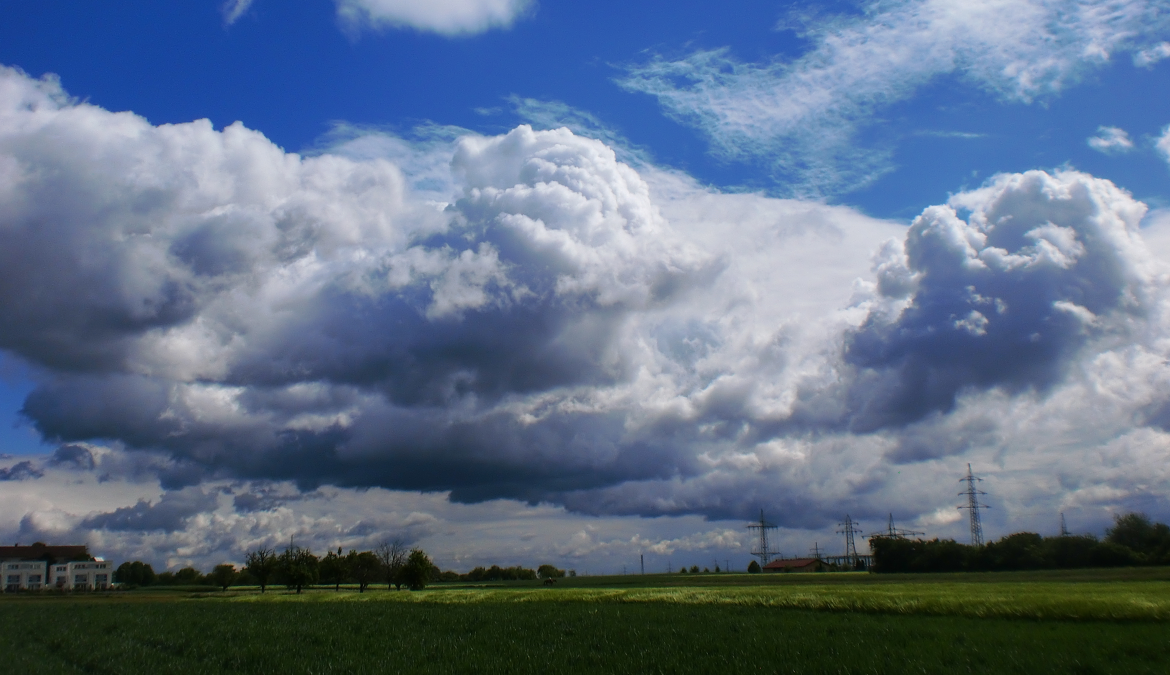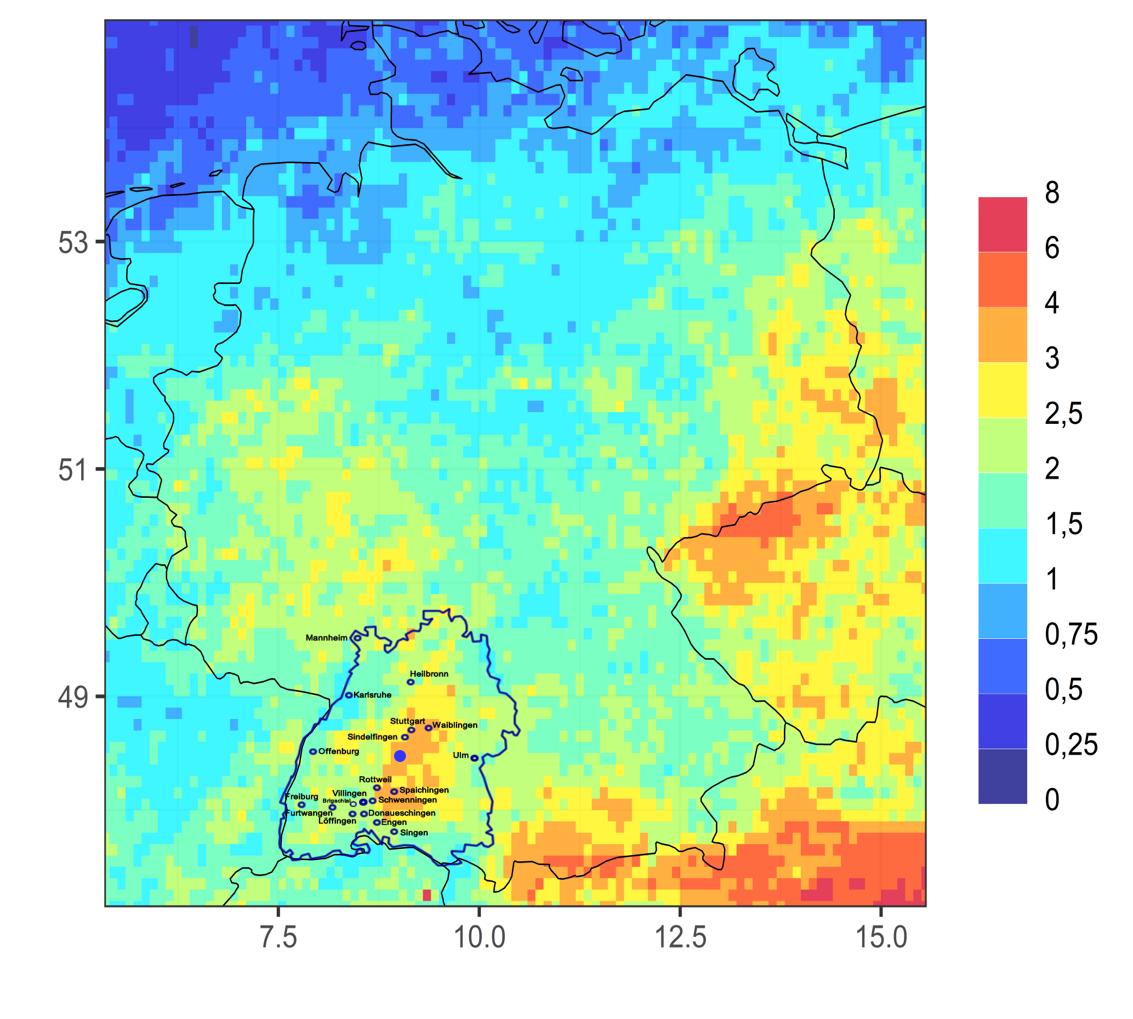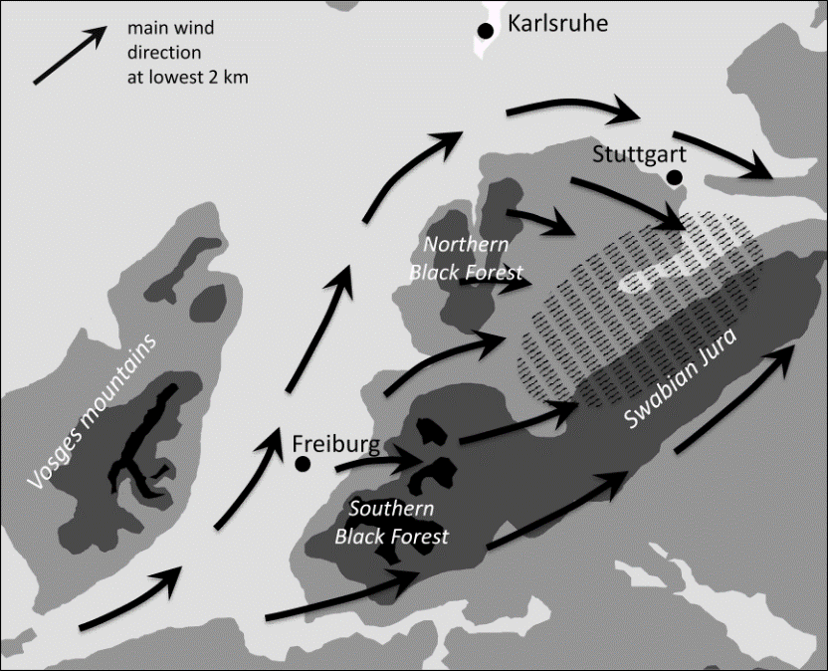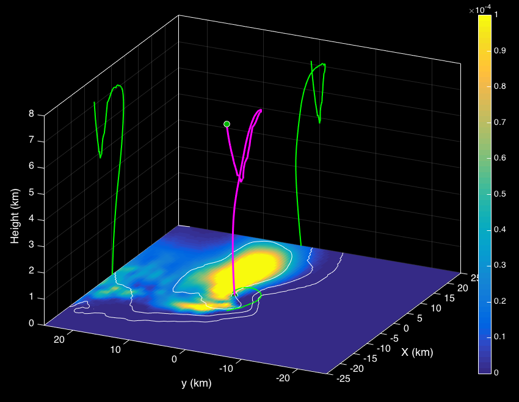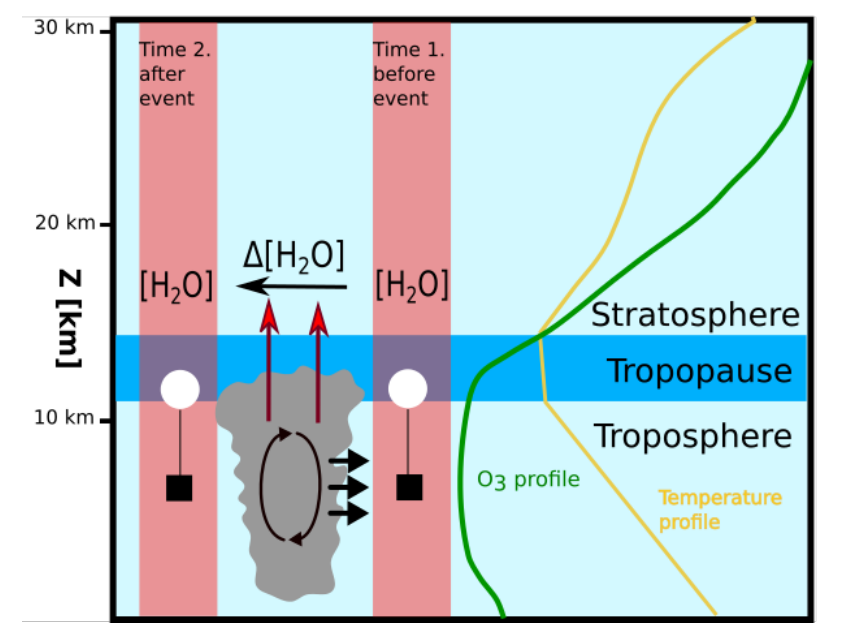Scientific background
Within the framework of the Swabian MOSES measurement campaign, scientists are investigating in particular local-scale thunderstorms associated with heavy rain and hail, large-scale heat waves and the associated droughts. Although these two types of extremes are triggered on very different temporal and spatial scales, they share several common characteristics: They are often associated with similar large-scale synoptic flow patterns such as atmospheric blocking. This flow pattern is characterized by large-scale weather patterns that hardly change over a longer period of time, sometimes even several weeks, and thus suppress the flow regime typical for the mid-latitudes (westerly wind drift). Affected regions can thus experience weather that differs significantly from the expected conditions for a longer period of time.
As a result, precipitation may be absent for weeks, and instead dry and warm air may be continuously transported the affected regions. Often, such heat waves are ended by the widespread occurrence of severe thunderstorms. These thunderstorms have a high potential to bring associated phenomena, such as extremely heavy rain and flash flooding, large hail, or convective strong wind gusts that can reach hurricane force. The frequency and intensity of both heat waves and severe thunderstorms have increased considerably in recent years due to climate change. In the study region in Baden-Württemberg, they represent the natural hazards with highest negative impacts: Thunderstorms cause the highest share of financial damage, heat waves claim the most lives.
With the highly industrialized Neckar valley and the open landscape of the Swabian Alb, the study area represents a unique landscape and settlement area that is ideally suited for the implementation of a combined and coordinated field experiment. The terrain has a large altitudinal gradient, the soil types change significantly over short distances, and the river catchments are rather small. The study area is one of the regions with the highest exposure to severe thunderstorms in Germany, but is also frequently affected by severe heat waves, the effects of which vary due to spatial differences in terrain characteristics and vegetation.
The approach of MOSES to reproduce and analyse the event chains of hydro-meteorological extremes aims on one hand at a better understanding of the mechanisms and processes decisive for the triggering and intensification of the events, on the other hand at a detailed investigation of their impacts and interactions with all their facets.
Information on the measurement systems used at Swabian MOSES can be found here.
Concrete Research Objectives
Soil moisture measurements
Soil moisture is a key control variable for rainwater runoff. This is because if the soil is very moist or extremely dry, rainwater can no longer be absorbed by the soil and runs off over the ground surface. This situation increases the risk of flooding. As an important parameter for the water availability of vegetation, soil moisture thus provides information on the prevailing drought stress in plants during prolonged periods of drought. Therefore, a good estimation of soil moisture in a large-scale area is crucial for early detection of impending weather extremes and their consequences.
The stationary sensors for the measurement of soil moisture by means of cosmic neutron detectors are already successfully used in research (see TERENO) and agriculture. Within the framework of Swabian MOSES, the potential of the mobile cosmic neutron detector (Cosmic Ray Roving, see figure) for large-scale soil moisture monitoring will be evaluated and refined. In addition, the integration of different technologies for soil moisture measurement from the temporally continuous point scale (local soil moisture sensors) to large-scale snapshots (e.g. with remote sensing data) will be refined towards purpose-oriented soil moisture products.
The data collected during the measurement campaign will be used to record the spatial distribution of soil moisture in the region and to track its temporal changes during the several months of the campaign. This shall enable in-depth study of extreme hydrological events, such as the development and impact of heat waves, and by this improve mesoscale hydrological models.
One such model is the mHM of UFZ which is basis to the drought monitor of Germany (see figure). This monitor provides maps of the daily drought status of the total soil and topsoil as well as the plant-available water in the soil.
Authors: Mandy Kasner, Prof. Dr. Peter Dietrich, UFZ
Additional information on Cosmic Ray Neutron Sensing & Roving and its use in other projects: Homepage
Drought stress
Extreme weather events are expected to increase in the context of global climate change. In particular, the occurrence of prolonged heat waves, which are often associated with a lack of precipitation, is becoming more likely for Central Europe. Due to the karstic subsoil and generally shallow soils in the Swabian Alb, the water storage capacity there is reduced and the ecosystems in the region are at increased risk of drought stress. The so-called Swabian stone fields are traditionally low-yielding and are expected to be particularly sensitive to changes in weather.
In order to record heat and drought stress on grassland in the Swabian Alb, several energy balance stations and the MoLEAF Tower will be set up, which will allow to derive vertical fluxes of energy, moisture and carbon dioxide (CO2) near the ground using e.g. the eddy covariance method. With the support of a Wingcopter drone, whose specially developed sensor pod is equipped with the measurement technology required for the eddy covariance method, it is possible to measure these relevant fluxes over a larger area. Like this, spatial patterns are to be identified and the area-based generalizability of the point measurements is to be evaluated. At the respective measuring stations, precipitation and soil moisture are measured in addition to air temperature and humidity.
The energy balance stations are located in Rottenburg am Neckar and in Burladingen-Ringingen. The MoLEAF system was stationed in Haigerloch-Hart. This results in a transect over several altitude levels from 338 m over 488 m up to 778 m above sea level with corresponding local climatic differentiation. Comparative analysis of these sites and accompanying biogeophysical modelling will be used to investigate the relationship between heat and drought stress on evapotranspiration, plant growth, crop yield and the greenhouse gas sink of these ecosystems, which are important for the region.
Extreme events like heat and drought periods have frequently appeared in Germany during the past years. These impact vegetation and entire ecosystems, but also affect the concentrations of trace gases and aerosol particles in the atmosphere. It is therefore of great interest how heat, droughts, soil moisture and meteorological parameters influence the spatial distribution, number concentration and size distribution of aerosol particles (see aerosol measurement systems) and to what extent there are feedbacks to meteorological phenomena.
Authors: Dr. Matthias Mauder, IMK-IFU, Prof. Dr. Torsten Sachs, GFZ & Dr. Harald Saathoff, IMK-AAF
Ice nucleating aerosol particles
The formation of ice particles in deep convective clouds such as thunderclouds impacts cloud development and precipitation. Ice formation is triggered by ice nucleating particles (INPs), a very small subset of the total aerosol particles. During the measurement campaign, INPs are measured quasi-continuously in the vicinity of convective clouds. The INP concentrations will be correlated with other aerosol particle measurements and meteorological parameters to investigate the role of aerosol particles and INPs in the formation of particularly deep convective clouds, which can develop into particularly severe thunderstorms.
Running waters
1. Heavy rainfall leads to high discharges in rivers and streams and the mobilization of suspended solids and pollutants with often unknown toxicity. Within the framework of Swabian MOSES, two rivers are studied which differ in terms of land use and degree of urbanisation (Ammer and Steinlach). The objectives are (i) to characterize the particle-bound and dissolved pollutants and (ii) their mixing toxicity during a flood event. Using an automated sampling procedure (Autosampler), water samples will be collected in high temporal resolution over the duration of a heavy rainfall event at two selected sites at the catchment outlets (Ammer and Steinlach). 2.
2. During heavy rainfall events, various tributaries contribute to water, particle fluxes and to pollutant inputs into the Ammer and Steinlach. A further objective is to identify and distinguish the main input pathways of dissolved and particle-associated pollutants in the catchment area of both watercourses. In particular, the focus is on runoff from motorways, urban areas including stormwater overflows from urban drainage and agricultural drainage ditches as the main sources of pollution. At selected locations, Autosampler were installed, supplemental scoop samples will be collected. In addition to organic contaminants and toxicity of mixtures, source-specific tracers such as dissolved organic carbon and heavy metals will be measured.
3. Rivers can be a significant source of greenhouse gases such as carbon dioxide (CO2), methane (CH4) and nitrous oxide (N2O). Within Swabian MOSES, the influence of hydrological extremes on the dynamics of greenhouse gas exchange between streams and the atmosphere is investigated, where catchments differ in land use and degree of urbanization. Manual samples are taken at regular intervals (weekly) from the Ammer, Steinlach and Goldersbach streams. As it is not yet clear how high the contribution of greenhouse gas emissions from watercourses or from external sources of surrounding land use is, samples are taken in high temporal resolution during heavy rainfall/flooding events. The samples are then analysed for greenhouse gases, carbon and nitrogen components dissolved in the water. Simultaneous measurement of stable water isotopes will provide information on the composition of runoff from e.g. groundwater and surface water.
Authors: Dr. Clarissa Glaser, University of Tübingen; Dr. Stephanie Spahr, University of Tübingen/IGB Berlin & Dr. PD Ralf Kiese, KIT
Thunderstorm frequency
One of the most challenging tasks for numerical weather prediction models is the prediction of high-level convection (thunderstorms). In particular, why, where, and under what environmental conditions (moist) convection is triggered in the atmosphere and whether the transition to high-level convection occurs is not yet fully understood.
The onset of convection requires an unstable stratified troposphere (lowest 10-15 kilometers of the atmosphere), a sufficient moisture supply, and a triggering mechanism that helps overcome convective inhibition in the deep tropospheric layers. Processes at the Earth's surface and in the atmospheric boundary layer (about the lowest kilometer of the troposphere) have a particular influence on the triggering of convection, especially when the flow in the middle and higher tropospheric layers is not as strong.
The triggering of convection by such boundary layer processes is often linked to spatial inhomogeneities of land use and/or soil water content. In addition, so-called convergence zones of different origin (e.g., due to slope or mountain-valley wind systems) are important phenomena. In such convergence zones, moisture-enriched air in the lower troposphere converges, resulting in strong upwelling motions as a compensation in the area of the convergence zone.
The Swabian MOSES study area in the Swabian Alb region is a hotspot for thunderstorms and hailstorms (see figure). Kunz and Puskeiler (2010) hypothesized that a pronounced convergence zone is created by flowing around the low mountain range, especially with weak to moderate southwesterly flow downstream of the Black Forest (see sketch). When it hits the Black Forest, the flow splits into two parts: one that flows around the northern Black Forest after channeling in the Rhine valley, and one that flows around the southern flank. Downstream of the Black Forest and upstream of the Swabian Alb, the two branches meet again and cause a convergence of the flow in the lower troposphere, which favors the onset or further intensification of (high-level) convection. This could be an explanation for the increased number of thunderstorms in the area of the Swabian Alb and the adjacent Neckar valley, which is also indicated by model simulations with the DWD 's COSMO model.
Within the framework of Swabian MOSES, convergence zones in the run-up to strong thunderstorms are to be detected. How the flow convergence develops during the course of the day as a function of the prevailing environmental conditions (i.e., flow velocity, direction, and stability) and how this is reflected in the development of thunderstorms will be investigated using wind measurements (research aircraft, balloon soundings, wind lidars, precipitation radar) and stability analyses(balloon soundings, microwave radiometer).
Authors: Prof. Dr. Michael Kunz, Jannik Wilhelm, IMK-TRO
Hail trajectories
The vertical temperature and humidity profile and the convective energy associated with it are decisive in determining whether thunderstorm events can develop in principle, and provide indications of their possible intensity. The three-dimensional (3D) wind field, on the other hand, determines the organizational form of thunderstorms in the form of single cells, multicell complexes, or supercells (strongest thunderstorms with rotating updrafts). In the upwind region of a thunderstorm cloud, the flow field also determines the strength of precipitation in the form of rain or hail. Operationally, vertical profiles are measured with radiosondes only twice a day and at only nine stations throughout Germany. Within the framework of Swabian MOSES, these measurements are carried out on special Intensive Observation Periods (IOPs) on the one hand with high temporal resolution with the aim of being able to better estimate the temporal development of the convection energy. On the other hand, measurements are made directly in the upwind region of a thunderstorm cell in order to analyze and better understand the unknown trajectories of the precipitation particles as a function of the prevailing ambient conditions.
Newly developed swarm probes from the Sparv company are used here, which are much smaller (the size of a yogurt cup) and lighter (12 grams) than conventional radiosondes. The probes ascend to a user-defined altitude and then follow the flow in the thundercloud on so-called Lagrangian orbits, from which hail trajectories can then be derived (see figure; graphic by Dennis & Kumjian, 2017). In a mobile deployment, the probes are launched in the immediate vicinity to a thundercloud, providing information from temperature, humidity, pressure, and the 3D wind field directly from the updraft-ideally from hail-producing thunderstorms (Markowski et al., 2018). Up to 17 balloon-borne probes can be launched and tracked simultaneously or sequentially.
The temporally / spatially high-resolution measurements of the swarm probes ideally complement the vertical profiles of wind, temperature, and humidity measured at other stations (radiosondes, microwave radiometers, wind lidar) by providing information on the temporal variability of environmental conditions that has not been observed in this level of detail before. In the case of hail events, the measured trajectories are related to the observed hail spectra from the hail sensors (HailSens) and various hail reports (DWD WarnWetter app, database of the European Severe Weather Database, ESWD) and compare them with model results.
Supercells with rotating updrafts mentioned at the beginning, which can produce very large hailstones, are also sources of low-frequency pressure fluctuations according to current research. These are detectable with ground-based infrasound microphones in the frequency range from a few to about 10 Hertz. Since there are very few observations of infrasound from thunderstorm cells to date where these measurements have been made in conjunction with comprehensive sensor technology to determine flow conditions in the cloud, as is available in the Swabian MOSES campaign, an infrasound sensor will also be operated throughout the campaign period.
Authors: Prof. Dr. Michael Kunz, IMK-TRO & Dr. Frank Hase, IMK-ASF
Trace gas profiles
Water vapour is one of the most important greenhouse gases in the atmosphere and is responsible for the natural greenhouse effect. The concentration of water vapour is mainly regulated by the air temperature, so that humidity decreases strongly with altitude. In atmospheric layers that are very dry, such as the lower stratosphere (above approx. 12 kilometers above sea level), small changes in water vapor concentration can make a lasting and significant contribution to the Earth's radiative budget and thus have an impact on climate (Riese et al., 2012).
Deep convection (such as thunderstorms) can significantly alter the trace gas composition in the upper troposphere (above approx. 10 kilometers above sea level). In the case of strong updrafts from a thunderstorm, overshooting convection can even transport tropospheric moist air masses and cloud particles across the tropopause and into the lower stratosphere (see graph (b) of Smith et al. 2017). Hence these air masses can strongly alter the water vapour distribution in the dry lower stratosphere. As the climate warms due to anthropogenic greenhouse gases, the more frequent occurrence and intensification of thunderstorms could introduce more water vapour into the lower stratosphere, causing additional warming of the climate. However, it is not yet clear how frequently such humidification by thunderstorms occurs, especially in the mid-latitudes, and how large the amount of water vapour transported via this process is. In addition to water vapour, other trace gases are transported upwards from the lower air layers, the quantity and influence of which still need to be investigated.
Both questions shall be investigated with balloon soundings by measuring the changes of trace gas profiles within these atmospheric layers before and after heavy thunderstorms (see picture). Depending on the situation and the strength of the convection, weather balloons will be launched either with small instrumentation (radiosondes to measure weather parameters) or larger instrumentation (radiosondes plus additional instruments such as hygrometers, AirCores) to accurately measure water vapour, ozone and greenhouse gas concentrations.
Author: Dr Christian Rolf, Research Centre Jülich


